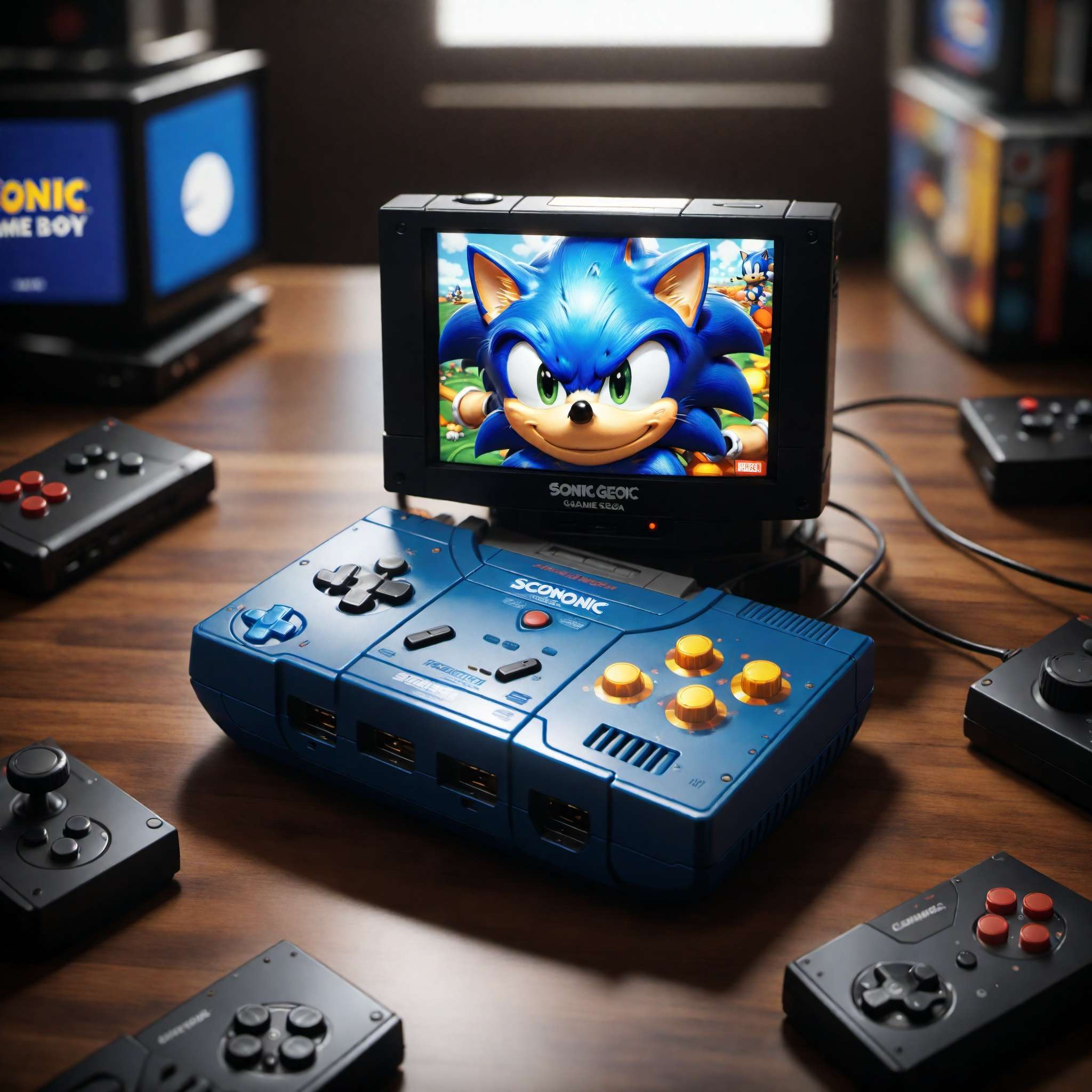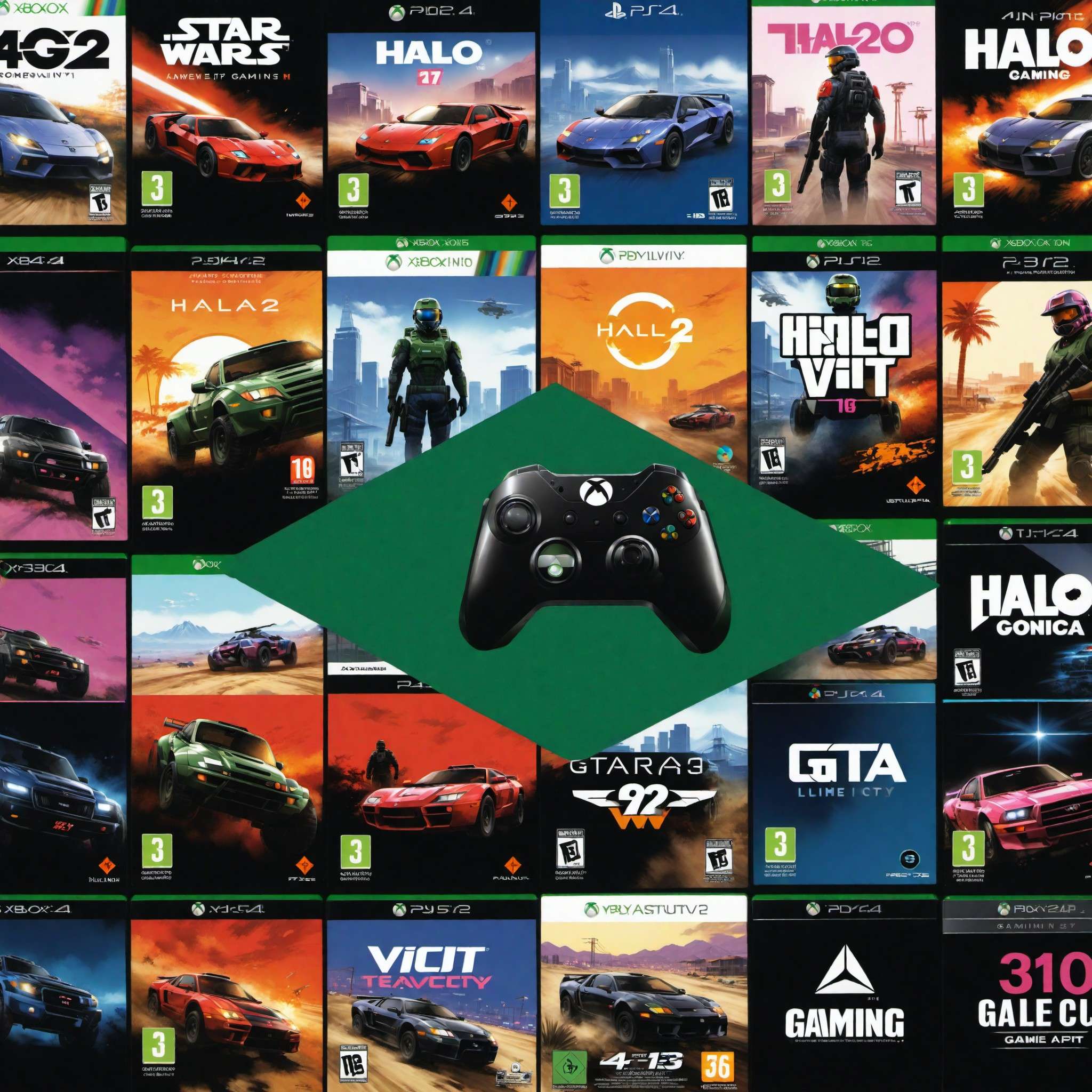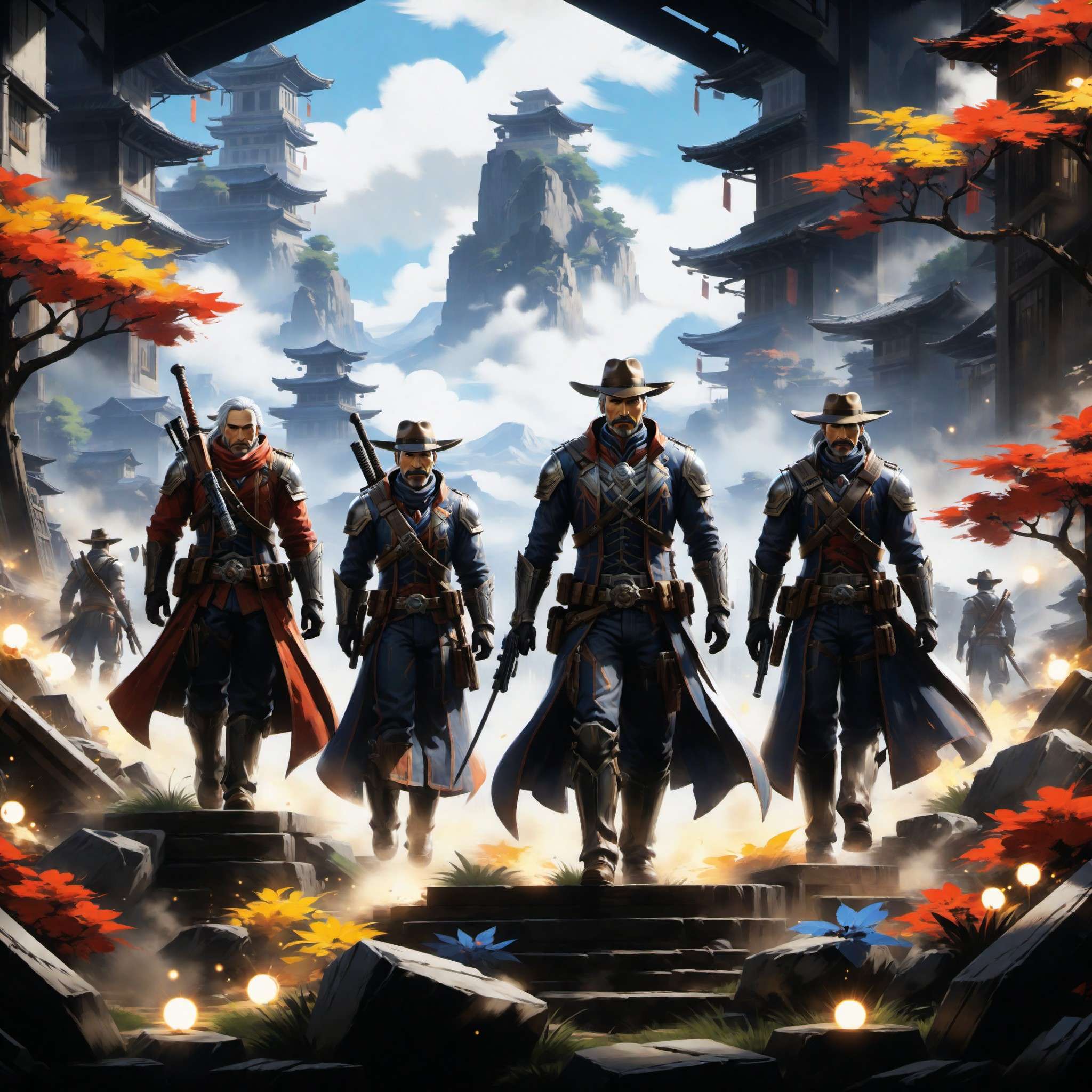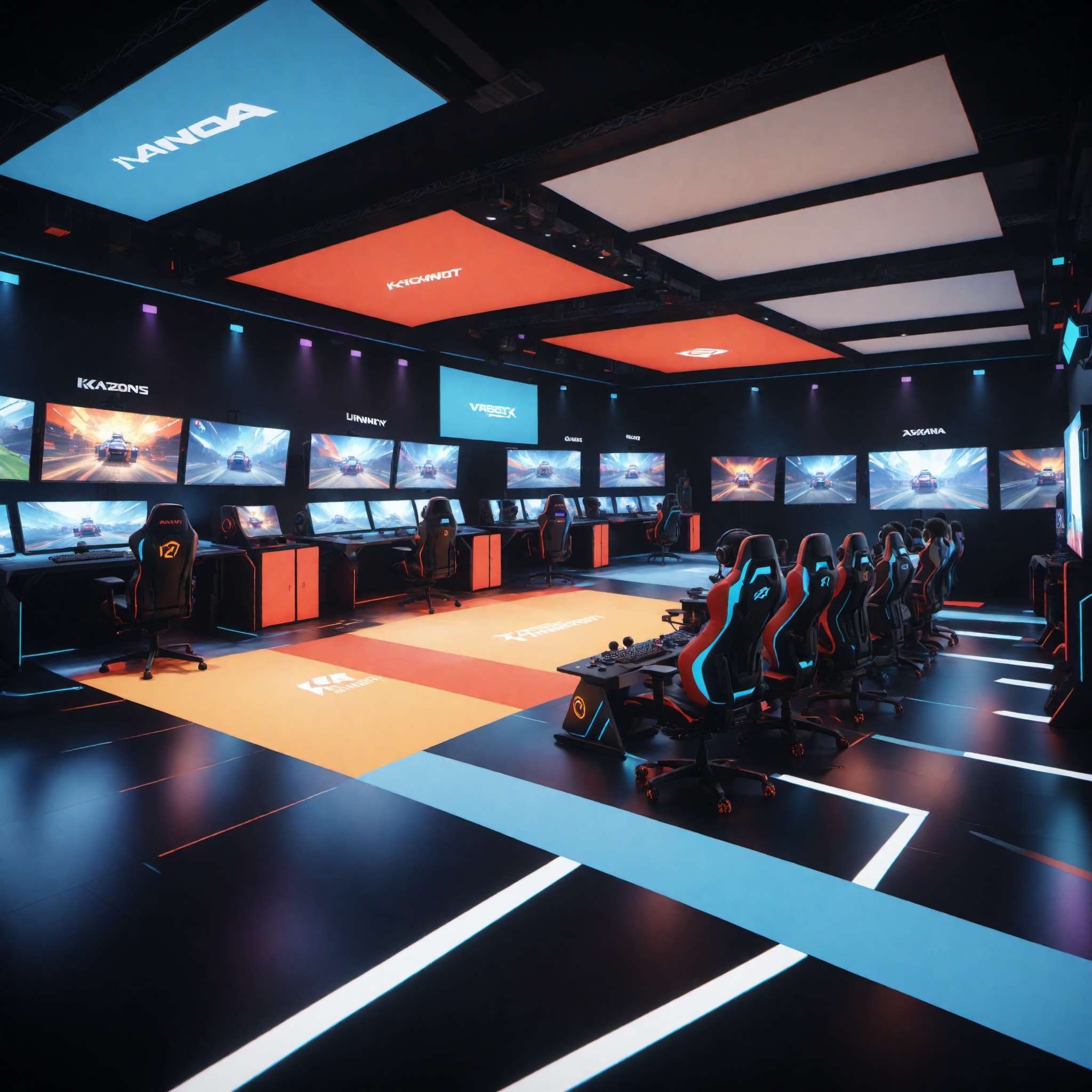Zombie Bunny is Reader-supported and may earn an affiliate commission through links on our site.

Decoding the Top 10 Console Games of All Time!
Unearth the magic of top-notch gaming with our pick of the Top 10 console games. Discover the thrill of engaging narratives & immersive gameplay. #ConsoleGaming #Top10
Embark on a captivating voyage through the evolution of console gaming with our comprehensive blog post, “Decoding the Top 10 Console Games of All Time!”. Journey from the birth of console gaming to the technologically advanced landscape of today, as we delve into the most influential games that made their mark in gaming history. Discover how console gaming has transformed from a simple form of entertainment to a global phenomenon, shaping popular culture and the way we interact with digital media. Whether you’re a seasoned gamer or a newcomer, this blog offers fascinating insights into the unforgettable adventures that have defined generations and reshaped the gaming landscape. Join us as we celebrate iconic characters and groundbreaking mechanics, all while exploring the broader cultural impact of console gaming.
Introduction

© Copyright , ZombieBunny.Org
Purpose of the blog
Welcome to “Decoding the Top 10 Console Games of All Time!”. In this comprehensive blog post, we’ll delve deep into the riveting world of console gaming, exploring its evolution and the significant impact it has had on popular culture. You’ll journey through time with us, from the very birth of console gaming to the technologically advanced world of today’s gaming industry. This blog aims to provide a thorough understanding of the most influential console games and their unique aspects that made them unforgettable in the hearts of gamers worldwide.
Console gaming has transformed from a simple form of entertainment to a global phenomenon, shaping the way we perceive and interact with digital media. The purpose of this blog is to celebrate this journey, focusing on the top 10 console games that have made a remarkable impression through their immersive storytelling, groundbreaking mechanics, or innovative gameplay. Whether you’re a seasoned gamer or a curious newcomer, this blog will offer you a fascinating insight into the console gaming universe. Let’s embark on this captivating voyage through the realm of console gaming, decoding the elements that make these games the undeniable masterpieces they are today.
Overview on console games
In the realm of digital entertainment, console games have carved a niche that transcends boundaries of age, culture, and geography. These games, with their captivating narratives, visually striking graphics, and engaging gameplay mechanics, have revolutionized the entertainment industry, becoming an integral part of our popular culture. The adventure of console gaming began with the simple, pixelated games of the 1970s and has evolved into today’s high-definition, immersive experiences that blur the line between virtual and reality.
While PC gaming and mobile gaming have their charms, console gaming holds a unique appeal. It’s not just about playing a game; it’s about being part of a larger community, sharing experiences, and creating memories. Console games have given us iconic characters who are as familiar to us as movie stars, memorable tales that resonate with us much like a bestselling novel, and experiences that are as emotionally impactful as any real-life event. From Super Mario’s cheerful world to the gritty landscapes of Grand Theft Auto, console games cover a vast spectrum of themes and styles, catering to a wide range of preferences. As we venture deeper into this blog, we’ll explore the top console games that have not only defined generations but also reshaped the gaming landscape, setting benchmarks for what games could aspire to be.
Scope of the blog
In this blog, we’ll be delving into the intricate details of the gaming world, exploring the evolution of console gaming through the decades. Our journey will take us from the birth of console gaming in the ’70s, through the golden age of the ’80s and ’90s, to the high-definition gaming experiences of today. We’ll take a close look at the development of gaming consoles, the technological advancements that propelled the industry forward, and the impact of these changes on the games themselves.
The heart of our journey, however, will be a deep dive into the top 10 console games of all time. These are games that have left an indelible mark on the gaming world, captivating audiences with their unique blend of storytelling, gameplay, and visual design. We’ll explore what makes these games stand out, delving into their history, the creative process behind their development, and the legacy they’ve left behind.
But our exploration won’t stop at the games themselves. We’ll also take a look at the broader cultural impact of console gaming, examining how it has influenced popular culture and society at large. Whether you’re a seasoned gamer looking to reminisce about your favorite titles, or a newcomer seeking to understand what makes these games so beloved, this blog is your comprehensive guide to the best that console gaming has to offer.
Genesis of Console Gaming

© Copyright , ZombieBunny.Org
Early days of console gaming
The tale of console gaming began in the early 1970s, a time when the concept of playing video games on a television set was a novelty. The first gaming console to make a significant impact was the Magnavox Odyssey, launched in 1972. It was a pioneering device that transformed the television into an interactive medium, albeit with simple and basic gameplay. Yet, it was the spark that ignited the flame of console gaming, paving the way for a revolution in digital entertainment.
The early days of console gaming were characterized by innovation and experimentation. Developers were exploring the potential of this new medium, creating games that, while primitive by today’s standards, were groundbreaking for their time. Pong, one of the earliest arcade games, was a sensation when it was ported to home consoles, turning the video game industry into a burgeoning field. These initial years marked the birth of an industry that would grow exponentially in the decades to come, laying the foundation for a diverse and immersive gaming landscape. The nascent days of console gaming were filled with remarkable advancements and unforgettable milestones that set the tone for the dynamic evolution of this industry. As we delve deeper, we will reveal how these early games and consoles paved the way for the iconic titles that we cherish today.
Rise of Atari
Atari, founded in 1972, soon emerged as a console gaming powerhouse and ushered in what many consider the first true golden age of video games. Their console, the Atari 2600, launched in 1977, was a landmark in the gaming industry. It popularized the use of game cartridges, allowing players to swap games easily, a revolutionary concept that increased the console’s versatility and appeal.
Atari’s influence extended beyond hardware; its iconic games played a crucial role in shaping the gaming landscape. Titles like “Space Invaders,” “Pac-Man,” and “Asteroids” became cultural phenomena, captivating players with their simple yet addictive gameplay. These games introduced novel concepts and mechanics that would become staples in the gaming industry. They were more than just games; they were experiences that brought people together, transcending the boundaries of age and culture.
The rise of Atari marked a significant shift in the gaming landscape. It established the console gaming market as a viable and profitable segment of the entertainment industry. Atari’s success laid the groundwork for future console manufacturers, setting standards for gameplay, graphics, and user experience. It was a pivotal time in gaming history, a period of rapid innovation and growth that set the stage for the dynamic and diverse world of console gaming we know today. As we explore further, we’ll see how these early successes set the stage for the console gaming revolutions to come.
Impact of Space Invaders and Pong
In the early days of console gaming, two games in particular stood out as pioneers: Pong and Space Invaders. These games not only helped popularize console gaming but also had a profound impact on the design and mechanics of future games.
Pong, released by Atari in 1972, was an incredibly simple game by today’s standards, yet it captured the public’s imagination like no other game had before. It revolutionized the gaming industry, proving that video games could be a popular form of entertainment. Pong’s success was instrumental in establishing the video game industry as a viable commercial endeavor.
Space Invaders, released in 1978, took the world by storm. The game’s addictive gameplay, combined with its science fiction theme, made it a cultural phenomenon. It introduced several new elements to the gaming world, such as high scores and waves of enemies, which are now standard features in many games. The game’s success led to a significant increase in the popularity of the Atari 2600 console, cementing Atari’s place as a leader in the gaming industry.
Both Pong and Space Invaders were more than just popular games; they were trendsetters that shaped the future of console gaming. They introduced new gameplay mechanics, set new standards for game design, and proved that video games could reach a wide audience. Their impact on the gaming industry can still be felt today, as they laid the groundwork for many of the gaming conventions we take for granted now.
Third Generation Consoles – Nintendo’s Dominance

© Copyright , ZombieBunny.Org
Introduction of NES
In the realm of console gaming, few names are as renowned or influential as Nintendo’s Entertainment System (NES). Launched in 1983 in Japan and 1985 in North America, the NES heralded a new era in console gaming, sparking what is often referred to as the “Nintendo revolution.” The introduction of the NES marked a significant shift in the gaming landscape, breathing new life into the industry after the video game crash of 1983.
The NES was innovative in several ways. Its design moved away from the computer-like aesthetics of previous consoles, adopting a more family-friendly appearance that would blend seamlessly with other household entertainment devices. But what truly set the NES apart was its game library. Nintendo introduced a strict quality control system for its games, ensuring that each title released on the platform met certain standards. This resulted in a collection of high-quality games that captivated players and defined the console.
The NES was more than just a gaming console; it was a catalyst that invigorated the console gaming industry. It introduced features and standards that are still in place today, from its iconic controller design to its emphasis on game quality. As we delve deeper into the world of console gaming, we’ll explore how the NES shaped the industry and paved the way for some of the most beloved games in history.
Popularity of Super Mario Bros.
The release of Super Mario Bros. in 1985 was a defining moment in the history of console gaming. This iconic game, bundled with the NES, played a pivotal role in the console’s success and solidified Nintendo’s dominance in the gaming world. The game’s charming characters, addictive platforming action, and memorable music captured the hearts of millions of players around the globe, making it one of the best-selling games of all time.
Super Mario Bros. introduced players to the enchanting Mushroom Kingdom and its beloved cast of characters, led by the titular Mario. The game’s creative level design, power-ups, and secret areas provided an unmatched level of depth and replayability. Its success established many conventions of the platforming genre, influencing countless games in the years to come.
The popularity of Super Mario Bros. was instrumental in shaping the future of Nintendo and the broader console gaming industry. It demonstrated the potential of video games as a form of entertainment, captivating audiences with its engaging gameplay and charming aesthetics. Super Mario Bros. wasn’t just a game; it was an experience that defined a generation of gamers. The game’s legacy lives on today, with the Mario franchise continuing to captivate players with new adventures. As we continue our journey through the history of console gaming, we’ll see how Super Mario Bros. set the stage for the evolution of the platforming genre and the rise of character-driven games.
Nintendo’s impact on gaming culture
Nintendo’s impact on gaming culture cannot be overstated. With the introduction of the NES and the success of Super Mario Bros., Nintendo not only revived the console gaming industry but also created a thriving culture around it. The company introduced characters and stories that have become ingrained in our popular culture, creating a shared language and set of experiences for gamers around the world.
Nintendo’s influence extends beyond its games. The company’s approach to design and development also shaped the industry, setting a high bar for quality and creativity. From the NES’s iconic controller design to the innovative gameplay mechanics in their games, Nintendo introduced elements that have become standard features in the gaming world.
But perhaps the most significant impact of Nintendo lies in the community it helped foster. By prioritizing fun, accessible gameplay and memorable characters, Nintendo games have brought people together, creating a sense of camaraderie and shared experience among gamers. Nintendo’s influence has transcended the boundaries of the gaming world, shaping our popular culture and leaving an indelible mark on generations of gamers.
As we continue our journey through the history of console gaming, we’ll see how Nintendo’s innovative approach and commitment to quality have influenced the gaming industry, paving the way for the rich, diverse world of console gaming we know today.
Era of Handheld and 16-bit Consoles

© Copyright , ZombieBunny.Org
Rise of handheld gaming
The late 1980s and early 90s marked the onset of a new era in console gaming – the rise of handheld gaming. The introduction of handheld gaming consoles, led by Nintendo’s Game Boy, brought about a significant shift in the gaming landscape. These portable devices offered a unique gaming experience, enabling players to engage in their favorite pastime anywhere, anytime.
The Game Boy, launched in 1989, was a groundbreaking device. With its compact size, long battery life, and robust game library, it quickly became a must-have gadget. It brought iconic games like Tetris and Pokémon to the palms of our hands, making gaming more accessible and personal than ever before.
The rise of handheld gaming challenged the conventions of console gaming, opening up new possibilities for game design and player interaction. These devices were more than just portable versions of home consoles; they were a new platform that offered unique gaming experiences, from puzzle games perfect for short sessions to epic adventures to lose oneself in. The success of handheld gaming devices was a testament to the evolving tastes and expectations of gamers, reflecting a growing desire for convenience and mobility in gaming. As we continue our journey through the history of console gaming, we’ll explore how this shift towards handheld gaming influenced the development of new games and consoles.
Sega vs Nintendo
The 90s witnessed a fierce rivalry that defined an era in console gaming — the battle between Sega and Nintendo. This period, often referred to as the “console wars,” was marked by intense competition, as both companies vied for dominance in the gaming market. The competition between Sega’s Genesis (Mega Drive outside North America) and Nintendo’s Super Nintendo Entertainment System (SNES) became one of the most iconic rivalries in gaming history.
Sega, with its edgy marketing and iconic mascot Sonic the Hedgehog, positioned itself as the cool, alternative choice for gamers. The Genesis, with its impressive speed and graphics, attracted a slightly older demographic, challenging Nintendo’s dominance. On the other hand, Nintendo continued to capitalize on its established franchises like Super Mario and The Legend of Zelda, maintaining a strong foothold in the market with the SNES.
The Sega vs. Nintendo rivalry was more than just a competition between two gaming giants; it spurred innovation and drove the industry forward. Each company strived to outdo the other, leading to remarkable advancements in graphics, game design, and storytelling. This competitive era pushed the boundaries of what was possible in console gaming, leading to the creation of some of the most memorable and influential games of all time. As we dive deeper into the history of console gaming, we’ll explore the lasting impact of this rivalry on the gaming landscape.
Iconic 16-bit games
The era of 16-bit gaming, propelled by the Super Nintendo Entertainment System (SNES) and Sega Genesis, gave birth to some of the most iconic games in the history of console gaming. These 16-bit games, with their advanced graphics and complex narratives, marked a significant leap forward in the gaming industry, offering players immersive experiences that transcended the boundaries of previous consoles.
Games like Super Mario World, Sonic the Hedgehog, and The Legend of Zelda: A Link to the Past became defining titles of this era. These games not only showcased the capabilities of 16-bit consoles but also pushed the boundaries of game design and storytelling. Their captivating narratives, coupled with engaging gameplay and impressive visual design, set new standards for what console games could be.
Super Mario World, with its expansive world and innovative power-ups, took the platforming genre to new heights. Sonic the Hedgehog, with its fast-paced gameplay and cool mascot, became a symbol of Sega’s edgy appeal. The Legend of Zelda: A Link to the Past, with its intricate puzzles and engaging storyline, set the template for future action-adventure games.
These iconic 16-bit games left a lasting impact on the gaming landscape, influencing countless games in the years to come. As we continue to delve into the history of console gaming, we’ll explore how these games helped shape the industry and set the stage for the future of console gaming.
Birth of 3D Gaming – PlayStation and N64

© Copyright , ZombieBunny.Org
Introduction of 3D gaming
The mid to late 90s marked a monumental shift in the gaming industry with the advent of 3D gaming. The introduction of Sony’s PlayStation and Nintendo’s N64 ushered in a new era of console gaming, featuring immersive 3D environments that added a new layer of depth and realism to games. This period was a turning point in the industry, pushing the boundaries of what was possible in video games and forever changing the landscape of console gaming.
The PlayStation, launched in 1994, and the N64, released in 1996, were groundbreaking in their capabilities. They offered advanced graphics and sound, allowing for the creation of complex 3D environments and engaging narratives that were previously unimaginable in console games. These consoles provided developers with a new canvas to express their creativity, leading to a wave of innovative games that redefined the gaming experience.
The introduction of 3D gaming was more than just a technological advancement; it was a transformative moment in the gaming industry. It paved the way for a new type of game design, one that prioritized immersion and narrative depth. As we delve deeper into the history of console gaming, we’ll explore how the advent of 3D gaming shaped the industry, influencing the development of games and consoles in the years to come.
Impact of PlayStation and N64
The impact of the PlayStation and N64 on the gaming industry was profound. These consoles, with their advanced 3D capabilities, marked a significant step forward in the evolution of console gaming. They shifted the industry’s focus towards creating immersive, realistic gaming experiences, leading to a new wave of innovative and influential games.
The PlayStation, with its powerful hardware and wide range of games, quickly became a favorite among gamers. It introduced iconic franchises like Final Fantasy, Metal Gear Solid, and Gran Turismo, which set new standards for storytelling and gameplay in console games. The PlayStation’s success established Sony as a major player in the gaming industry, creating a new competitor for Nintendo and Sega.
On the other hand, the N64, with its innovative controller and emphasis on multiplayer gaming, carved its own niche in the market. Games like Super Mario 64, The Legend of Zelda: Ocarina of Time, and GoldenEye 007 showcased the console’s capabilities, offering unprecedented levels of immersion and interactivity.
The impact of the PlayStation and N64 extended beyond their hardware and games. They helped shape the future of the gaming industry, influencing the development of later consoles and games. Their focus on 3D graphics, immersive storytelling, and multiplayer gaming set new trends in the industry, paving the way for the dynamic, diverse world of console gaming we know today.
Iconic 3D games
The birth of 3D gaming brought forth a slew of iconic games that left an indelible mark on the gaming industry. These games pushed the boundaries of what was possible in video games, offering players immersive experiences that transcended the flat, pixelated worlds of earlier games.
One of the most iconic 3D games of this era was Super Mario 64, released for the N64 in 1996. This game revolutionized the platforming genre with its innovative 3D gameplay and expansive world, setting a new standard for console games. Its influence can still be felt today in the design of 3D platformers.
On the PlayStation, Metal Gear Solid became a landmark title. Released in 1998, this game melded gripping storytelling with stealth-based gameplay, creating a cinematic experience that was unlike anything that had come before. Its blend of gameplay and narrative set a new benchmark for video game storytelling.
Another iconic game of this era was The Legend of Zelda: Ocarina of Time. Released for the N64 in 1998, it took the beloved Zelda franchise into the third dimension, delivering an epic adventure that is still considered one of the greatest games of all time.
These games, along with others like Resident Evil, Gran Turismo, and Final Fantasy VII, defined the era of 3D gaming. They set new standards for graphics, gameplay, and storytelling, leaving a lasting legacy that continues to shape the gaming industry today.
The Sixth Generation Revolution

© Copyright , ZombieBunny.Org
Introduction of Xbox
The dawn of the new millennium brought with it a significant new player in the console gaming industry — Microsoft. In 2001, Microsoft launched its first gaming console, the Xbox, marking the start of a new era in console gaming. With its powerful hardware, online gaming capabilities, and robust game library, the Xbox represented a significant leap forward in the console gaming landscape.
The Xbox was a game-changer, introducing features that would become staples in future generations of consoles. With its built-in hard drive, it offered players the ability to save games and download content directly to the console, a feature that was unique at the time. Its Xbox Live service, launched in 2002, brought online multiplayer gaming to the forefront, revolutionizing the way players interact with each other.
But the Xbox was more than just a piece of hardware; it was a platform that brought forth some of the most iconic games of the 21st century. Games like Halo: Combat Evolved and Fable became defining titles of the Xbox, showcasing the console’s capabilities and setting new standards for gameplay and storytelling.
The introduction of the Xbox marked a significant shift in the gaming industry, bringing a new competitor to the console gaming market and pushing the boundaries of what was possible in video games. As we delve deeper into the history of console gaming, we’ll explore the Xbox’s impact on the industry and its influence on future generations of consoles.
PS2’s record-breaking sales
The sixth generation of consoles saw a fierce competition between Microsoft’s newly launched Xbox, Nintendo’s GameCube, and Sony’s PlayStation 2 (PS2). Among these, PS2 emerged as an undeniable leader, achieving record-breaking sales and leaving a lasting impact on the gaming landscape. Launched in 2000, PS2 quickly became a fan favorite, thanks to its impressive hardware, wide array of games, and backward compatibility with PlayStation games.
The PS2’s success can be attributed to its remarkable game library, which included titles from a wide variety of genres. Games like Grand Theft Auto III, Metal Gear Solid 2, and Final Fantasy X captivated players with their engaging gameplay and compelling narratives, making the PS2 a must-have console for gamers. Its ability to play DVD movies also added to its appeal, making it a versatile entertainment device.
The PS2’s record-breaking sales solidified Sony’s position as a leader in the console gaming industry. By the end of its lifespan, the PS2 had sold over 155 million units worldwide, making it the best-selling console of all time. Its success was a testament to Sony’s understanding of gamers’ needs and desires, offering a combination of powerful hardware, innovative features, and a diverse game library.
The PS2’s success had a significant impact on the gaming industry, influencing the development of future consoles and setting new standards for console gaming. As we continue to explore the history of console gaming, we’ll delve deeper into the PS2’s legacy and its influence on the gaming landscape.
Influential games of the era
The sixth generation of consoles brought forth some of the most influential games in the history of console gaming. These games pushed the boundaries of what was possible in video games, offering players immersive experiences that transcended the limits of previous consoles.
One of the most iconic games of this era was Grand Theft Auto III. Released for the PlayStation 2 in 2001, it introduced players to a vast, open-world environment where they could freely explore and interact with their surroundings. Its success paved the way for the popularity of open-world games, influencing countless titles in the years to come.
On the Xbox, Halo: Combat Evolved became a defining title. Its engaging narrative, innovative gameplay, and groundbreaking multiplayer mode set a new standard for first-person shooters. Halo’s success established the Xbox as a serious contender in the console gaming market, and its influence can still be felt in the FPS genre today.
The Legend of Zelda: The Wind Waker, released for the GameCube in 2002, was another influential game of this era. Its unique art style and innovative gameplay mechanics left a lasting impression on players and critics alike, shaping the future of the beloved Zelda franchise.
These influential games, along with others like Metal Gear Solid 2, Final Fantasy X, and Resident Evil 4, defined the era of sixth-generation consoles. They pushed the boundaries of game design and storytelling, leaving a lasting legacy that continues to shape the gaming industry today.
Seventh Generation – The Online Gaming Era

© Copyright , ZombieBunny.Org
Rise of online gaming
The seventh generation of consoles marked the rise of online gaming, a significant shift that would forever change the landscape of console gaming. With the introduction of Microsoft’s Xbox 360, Sony’s PlayStation 3, and Nintendo’s Wii, online connectivity became a central feature, allowing players to compete and cooperate with others around the world.
The Xbox 360, launched in 2005, played a pivotal role in popularizing online gaming. Its Xbox Live service, which had been introduced with the original Xbox, was significantly expanded, offering a robust online multiplayer platform for games like Halo 3 and Gears of War. The service also included features like voice chat, friend lists, and digital content downloads, setting a new standard for online gaming services.
Sony’s PlayStation 3, with its PlayStation Network, also contributed significantly to the rise of online gaming, offering similar features to Xbox Live. Meanwhile, Nintendo’s Wii focused more on local multiplayer and innovative motion controls, though it also offered online features through the Nintendo Wi-Fi Connection.
The rise of online gaming represented a significant shift in the gaming industry, offering new ways for players to connect and compete. It transformed gaming from a solitary or local multiplayer activity into a global, social experience. As we delve deeper into the history of console gaming, we’ll explore how this shift towards online gaming influenced the development of new games and consoles, and how it continues to shape the industry today.
Impact of Wii’s motion control
In the seventh generation of consoles, Nintendo’s Wii brought a significant innovation that changed the way we interact with games — motion control. Launched in 2006, the Wii introduced the Wii Remote, a controller equipped with motion-sensing technology. This device allowed players to control games through physical movements, creating a new level of immersion and interactivity.
The Wii’s motion controls were a game-changer. They opened up a whole new way of playing, transforming gaming from a passive activity to an active, physical experience. Games like Wii Sports, Wii Fit, and The Legend of Zelda: Skyward Sword took full advantage of these controls, offering unique gameplay experiences that were both fun and intuitive.
The impact of the Wii’s motion controls extended beyond the Wii itself. They challenged the conventions of game design, inspiring developers to think outside the box and explore new ways of engaging players. The success of the Wii’s motion controls also spurred other companies to develop their own motion-sensing technologies, leading to devices like the PlayStation Move and the Xbox Kinect.
The Wii’s motion controls were more than just a novelty; they were a transformative innovation that changed the gaming landscape. As we continue to explore the history of console gaming, we’ll delve deeper into the impact of the Wii’s motion controls and how they shaped the future of gaming.
Notable games of the generation
The seventh generation of consoles brought forth a slew of notable games that left a lasting impression on the gaming landscape. These games pushed the boundaries of what was possible in video games, taking advantage of the enhanced graphics, online capabilities, and innovative controls of the new consoles.
One of the most iconic games of this era was Halo 3, released for the Xbox 360 in 2007. The game was a landmark title for online multiplayer gaming, offering an immersive and competitive experience that set the standard for future first-person shooters.
On the PlayStation 3, Uncharted 2: Among Thieves became a standout title. Released in 2009, the game was praised for its cinematic storytelling, engaging gameplay, and impressive visuals, setting a new bar for action-adventure games.
On the Wii, Wii Sports became a cultural phenomenon. Its intuitive motion controls and fun, accessible gameplay made it a hit with players of all ages, showcasing the potential of the Wii’s unique control scheme.
These games, along with others like Call of Duty: Modern Warfare, The Legend of Zelda: Skyward Sword, and Grand Theft Auto IV, defined the era of seventh-generation consoles. They pushed the boundaries of game design and storytelling, leaving a lasting legacy that continues to shape the gaming industry today. As we continue to explore the history of console gaming, we’ll delve deeper into the impact of these notable games.
Eighth Generation – The HD Gaming Era

© Copyright , ZombieBunny.Org
Introduction of HD gaming
The eighth generation of consoles, marked by the introduction of Sony’s PlayStation 4, Microsoft’s Xbox One, and Nintendo’s Wii U and later the Switch, ushered in the era of High Definition (HD) gaming. With the advent of these consoles, games took a significant leap forward in terms of visual fidelity, offering players immersive experiences with stunningly detailed environments and lifelike characters.
HD gaming was more than just a visual upgrade; it represented a significant shift in the gaming landscape. Games now had the ability to create more detailed and realistic worlds, enhancing immersion and bringing game narratives to life in a way that was not possible before. This leap in visual quality opened up new possibilities for game design, allowing developers to create more complex and engaging experiences.
The PlayStation 4 and Xbox One, launched in 2013, were at the forefront of this transition. Both consoles offered powerful hardware capable of rendering games in full HD, and later updates enabled even higher resolutions. Nintendo’s approach differed, with the Wii U focusing on dual-screen gameplay and the Switch emphasizing portability alongside its HD capabilities.
The introduction of HD gaming marked a significant milestone in the history of console gaming, offering a new level of immersion and realism. As we continue to explore the history of console gaming, we’ll delve into the impact of HD gaming on the industry and how it continues to shape the future of gaming.
Impact of Nintendo Switch’s portability
In the eighth generation of consoles, Nintendo’s Switch brought a significant innovation that once again changed the way we interact with games — portability. Launched in 2017, the Switch offered the power of a home console with the flexibility of a handheld device, allowing gamers to enjoy their favorite games wherever they go.
The impact of the Switch’s portability was profound. It blurred the lines between home and handheld consoles, offering a hybrid device that catered to a wide range of gaming needs. For the first time, players could enjoy the same games on their TV at home and on the go, bringing a new level of freedom and flexibility to console gaming.
Moreover, the Switch’s portability opened up new possibilities for multiplayer gaming. With its detachable Joy-Con controllers, the Switch made it easy to share the fun with friends, whether at home or on the go. Games like Super Mario Odyssey, The Legend of Zelda: Breath of the Wild, and Splatoon 2 took full advantage of these features, offering unique gameplay experiences that were both fun and accessible.
The Switch’s portability was more than just a convenient feature; it was a transformative innovation that challenged the conventions of console gaming. As we continue to explore the history of console gaming, we’ll delve deeper into the impact of the Switch’s portability and how it continues to shape the future of gaming.
Outstanding games of the generation
The eighth generation of consoles brought forth a multitude of outstanding games that pushed the boundaries of what was possible in video games. These games, with their detailed HD visuals and innovative gameplay, offered players immersive experiences that set new standards for console gaming.
On the PlayStation 4, games like The Last of Us Part II and God of War became standout titles. Both games were hailed for their compelling narratives, engaging gameplay, and stunning visuals, showcasing the potential of HD gaming on the console.
On the Xbox One, titles like Forza Horizon 4 and Gears 5 stood out. These games offered high-octane action and impressive visuals, demonstrating the capabilities of the console.
On the Nintendo Switch, The Legend of Zelda: Breath of the Wild and Super Mario Odyssey were defining titles. Both games utilized the Switch’s unique features to offer innovative gameplay experiences that were both fun and immersive.
These outstanding games, along with others like Red Dead Redemption 2, Horizon Zero Dawn, and Splatoon 2, defined the era of eighth-generation consoles. They pushed the boundaries of game design and storytelling, leaving a lasting legacy that continues to influence the gaming industry. As we continue to delve into the history of console gaming, we’ll explore the impact of these outstanding games and how they continue to shape the future of gaming.
Ninth Generation – The Next Level

© Copyright , ZombieBunny.Org
Introduction of ninth generation consoles
The ninth generation of consoles, marked by the introduction of Sony’s PlayStation 5 and Microsoft’s Xbox Series X and Series S, represents the next level in console gaming. Launched in 2020, these consoles promise to deliver unprecedented levels of performance and visual fidelity, taking gaming experiences to new heights.
The PlayStation 5, with its powerful custom CPU and GPU, and high-speed SSD, is designed to eliminate loading times, offer high frame rates, and render games in up to 8K resolution. The DualSense controller, with its haptic feedback and adaptive triggers, aims to enhance immersion by allowing players to feel the tension and impact of their in-game actions.
Similarly, the Xbox Series X and Series S offer impressive technical specs, with the Series X boasting 12 teraflops of power and the ability to play games in up to 8K. Both consoles also feature high-speed SSDs and support for real-time ray tracing, a technology that allows for more realistic lighting and reflections.
The introduction of these ninth-generation consoles marks a significant milestone in the evolution of console gaming. With their advanced hardware and innovative features, they promise to deliver more immersive and visually stunning gaming experiences than ever before. As we delve into the latest chapter in the history of console gaming, we’ll explore the potential of these next-generation consoles and the exciting future they herald for the gaming industry.
Impact of VR and AR
As we move into the ninth generation of consoles, the impact of Virtual Reality (VR) and Augmented Reality (AR) technologies cannot be underestimated. These technologies, which offer immersive and interactive experiences that transcend the traditional gaming format, are becoming increasingly prominent in the console gaming landscape.
Sony’s PlayStation VR, launched in 2016 for the PlayStation 4 and compatible with the PlayStation 5, represents one of the most significant forays into VR gaming. Offering a library of VR games, from action-packed shooters to immersive narrative adventures, PlayStation VR brings players into the heart of the gaming action.
AR, while less prevalent in the console market, has seen success in mobile gaming and is poised to make a significant impact on console gaming in the future. AR games overlay game elements onto the real world, creating interactive experiences that blur the line between reality and the virtual world.
The impact of VR and AR technologies extends beyond the games themselves. They present new opportunities and challenges for game developers, pushing them to explore new ways of engaging players and creating immersive experiences. As we delve into the future of console gaming, we’ll explore how these technologies are shaping the industry, influencing the development of new games and consoles, and redefining what it means to play.
Promising games of the generation
As we step into the ninth generation of console gaming, a number of promising games are already making their mark, showcasing the capabilities of the latest consoles and hinting at the exciting future of gaming.
On the PlayStation 5, games like “Demon’s Souls”, a remake of the 2009 classic, and “Ratchet & Clank: Rift Apart”, an interdimensional adventure, are pushing the boundaries of console gaming with their stunning visuals, swift load times, and immersive gameplay.
For the Xbox Series X and Series S, “Halo Infinite” promises to be a flagship title, offering a fresh take on the iconic franchise with its expansive world and advanced graphics. Other games like “Fable”, a new installment in the beloved RPG series, are anticipated to showcase the power and potential of the new Xbox consoles.
While it’s still early days for the ninth generation, these promising games represent just a glimpse of what’s to come. With the advanced capabilities of the new consoles, developers have more tools than ever to create immersive and visually stunning gaming experiences.
As we continue to navigate the next level of console gaming, we can expect to see games that push the boundaries of what’s possible, offering increasingly immersive experiences that captivate players and redefine the world of gaming. As the ninth generation unfolds, it promises to be an exciting time for gamers everywhere.
Top 10 Console Games of All Time

© Copyright , ZombieBunny.Org
Countdown of top 10 console games
As we journey through the history of console gaming, it’s time to highlight the top 10 console games that have left an indelible mark on the gaming landscape. These games, with their innovative gameplay, compelling narratives, and groundbreaking features, have set new standards in the industry and captivated players around the world.
Beginning our countdown at number 10 is “Metal Gear Solid” for the PlayStation. This game revolutionized the stealth genre with its deep narrative and immersive gameplay. Moving on to number 9, we have “Super Mario 64” for the N64, a game that set new standards for 3D platforming with its expansive world and innovative controls.
At number 8, we find “Halo: Combat Evolved” for the Xbox. This game transformed the first-person shooter genre with its engaging multiplayer mode and rich sci-fi narrative. Number 7 brings us “The Legend of Zelda: Ocarina of Time” for the N64, an epic adventure that is often hailed as one of the greatest games of all time.
The countdown continues with other iconic games like “Grand Theft Auto III”, “Final Fantasy VII”, “The Last of Us”, and “Red Dead Redemption 2”, leading up to the top spot. Each of these games has made a significant impact on the gaming industry, shaping the evolution of console gaming and leaving a lasting legacy that continues to inspire developers and captivate players today. As we conclude our journey through the history of console gaming, it’s clear that these games represent the best of what the medium has to offer.
Brief on each game’s impact
Each of the top 10 console games has had a significant impact on the gaming industry, pushing the boundaries of what’s possible in video games and setting new standards for gameplay, storytelling, and design.
“Metal Gear Solid”, for example, was a pivotal game in the stealth genre. Its deep narrative and immersive gameplay introduced a level of complexity and maturity that was rare in video games at the time, influencing numerous games in the years to come.
“Super Mario 64” revolutionized 3D platforming with its expansive world and innovative controls. It set a new standard for the genre and demonstrated the potential of 3D gaming, leaving a lasting impact on the industry.
“Halo: Combat Evolved” transformed the first-person shooter genre with its engaging multiplayer mode and rich sci-fi narrative. Its success established the Xbox as a serious contender in the console gaming market, and its influence can still be felt in the FPS genre today.
“The Legend of Zelda: Ocarina of Time” is often hailed as one of the greatest games of all time. Its epic adventure, innovative gameplay, and captivating story set a new benchmark for action-adventure games, influencing countless titles in the years to follow.
Each of these games, along with others like “Grand Theft Auto III”, “Final Fantasy VII”, “The Last of Us”, and “Red Dead Redemption 2”, has left a significant mark on the industry, shaping the evolution of console gaming and leaving a lasting legacy that continues to inspire developers and captivate players today.
Why they are the best
The top 10 console games are recognized as the best for several reasons. They are not only commercially successful but also critically acclaimed, often hailed by critics for their innovative design, compelling narratives, and engaging gameplay.
These games have pushed the boundaries of what’s possible in video games, offering players immersive experiences that go beyond mere entertainment. They have challenged players with complex narratives, intricate gameplay mechanics, and richly detailed worlds, engaging their minds and emotions in ways that few other games have achieved.
Their impact extends beyond the games themselves. They have influenced countless other games, inspiring developers to think outside the box and explore new ways of engaging players. They have set new standards for gameplay, storytelling, and design, raising the bar for what’s expected in a video game.
But perhaps most importantly, these games have captivated players around the world, creating memorable experiences that have shaped their understanding and appreciation of video games. Whether it’s the epic adventure of “The Legend of Zelda: Ocarina of Time”, the immersive stealth action of “Metal Gear Solid”, or the gripping narrative of “The Last of Us”, these games have resonated with players on a deep and personal level.
These reasons, among many others, are why these games are considered the best. They represent the pinnacle of console gaming, showcasing the potential of the medium and setting a benchmark for future generations of games.
The Impact of Console Gaming on Society

© Copyright , ZombieBunny.Org
E-sports and competitive gaming
The impact of console gaming on society extends beyond the living room, influencing industries and cultural phenomena across the globe. One of the most significant impacts has been the rise of e-sports and competitive gaming.
E-sports, where players compete in video game tournaments for fame and fortune, has grown exponentially over the past decade, thanks in part to console gaming. Games like Call of Duty, Halo, and Street Fighter, which were popularized on consoles, have become mainstays in the e-sports circuit, with major tournaments broadcast live around the world.
The rise of e-sports has transformed gaming from a solitary or casual social activity into a recognized sport. Players, often part of professional teams, train rigorously to compete at the highest level, while fans pack stadiums or tune in online to watch these competitions, much like traditional sports.
Moreover, e-sports has opened up new career opportunities, from professional players and coaches to broadcasters and game analysts. It has also spurred the growth of related industries, such as game streaming, where players broadcast their gameplay live to an online audience.
The rise of e-sports and competitive gaming is a testament to the cultural impact of console gaming. It’s a phenomenon that has changed the perception of video games, demonstrating their potential as a competitive sport and a form of entertainment that rivals traditional sports and media. As we continue to explore the impact of console gaming on society, we’ll delve deeper into the world of e-sports and its influence on the gaming landscape.
Gaming and pop culture
Console gaming has had a profound impact on pop culture, influencing everything from music and film to fashion and literature. Video game characters and themes have become iconic symbols, recognized and loved by millions around the world.
Characters like Mario, Sonic, and Link have transcended their game worlds to become cultural icons. They’ve appeared in everything from TV shows and movies to merchandise and theme parks, becoming recognizable figures even to those who’ve never picked up a controller.
Moreover, the narratives and worlds created in video games have influenced other media. Films like “Tron” and “Ready Player One” draw heavily on video game aesthetics and themes, while books like “Snow Crash” and “Neuromancer” have been inspired by the virtual worlds created in games.
Video game music, once a niche interest, has also become a significant part of pop culture. Composers like Koji Kondo and Nobuo Uematsu have created scores that are enjoyed by fans around the world, both within the context of the games and as standalone pieces of music.
Even fashion has felt the influence of gaming, with clothing brands releasing collections inspired by popular games and characters. Gaming has also influenced the world of sports, with e-sports becoming a recognized competitive discipline.
The influence of console gaming on pop culture is a testament to the medium’s impact and reach. As we continue to explore the history and impact of console gaming, we’ll delve deeper into its influence on pop culture and how it continues to shape our cultural landscape.
Gaming communities and friendships
Console gaming has significantly influenced social interactions and community-building, creating spaces for players to connect, collaborate, and form friendships. Through online multiplayer games and social features, console gaming has fostered vibrant communities of players who share common interests and passions.
Games like “Fortnite”, “Call of Duty”, and “Overwatch” offer online multiplayer modes that allow players to team up and compete against others around the world. These games provide platforms for social interaction, where players can communicate, strategize, and build relationships with each other.
Moreover, console gaming has facilitated the creation of communities outside of the games themselves. Online forums, social media groups, and fan websites have sprung up around popular games, providing spaces for players to discuss strategies, share fan art, and connect over shared gaming experiences.
These gaming communities are not just limited to the virtual world. Many gaming communities organize real-world meetups and conventions, where fans can come together to celebrate their shared passion for gaming.
Furthermore, console gaming has also played a role in forming friendships. Many players form strong bonds with their gaming companions, with these relationships often extending beyond the game.
The impact of console gaming on social interactions and community-building is a testament to the medium’s power to connect people. As we continue to explore the history and impact of console gaming, we’ll delve deeper into the role of gaming communities and friendships in shaping our social landscape.
Conclusion

© Copyright , ZombieBunny.Org
Recap of the blog
As we’ve journeyed through the history of console gaming, we’ve explored the evolution of the medium, from the early days of Atari to the latest ninth generation consoles. We’ve delved into the top 10 console games of all time, examining why they are regarded as the best, and how they’ve influenced the industry and defined the gaming experiences of millions of players worldwide.
We’ve looked at the transformative innovations each generation brought, like the introduction of 3D graphics, motion controls, online gaming, HD gaming, and the advent of VR and AR. We’ve seen how each new generation of consoles pushed the boundaries of what was possible in gaming, offering players increasingly immersive and engaging experiences.
We’ve also examined the broader impact of console gaming on society, from the rise of e-sports and competitive gaming to its influence on pop culture and the formation of vibrant gaming communities and friendships. We’ve seen how console gaming has transcended its medium to become a significant cultural phenomenon, shaping our social interactions, influencing other industries, and becoming an integral part of our cultural landscape.
Through this exploration, we’ve seen how console gaming has evolved over the decades, continually pushing the boundaries of entertainment and technology. As we look to the future, it’s clear that console gaming will continue to innovate and captivate, shaping the future of entertainment and continuing to bring us unforgettable gaming experiences.
Future of console gaming
As we look to the future of console gaming, there’s a great deal of anticipation and excitement around what’s to come. Armed with advanced technology and lessons from the past, the future of console gaming promises to bring us even more immersive, innovative, and engaging experiences.
With the ninth generation of consoles, we’re already seeing a glimpse of the future. From the advanced hardware and high-speed SSDs of the PlayStation 5 and Xbox Series X|S, to the unique hybrid design of the Nintendo Switch, these consoles are pushing the boundaries of what’s possible in gaming.
Future advancements in technology like ray tracing, virtual reality (VR), and augmented reality (AR) are set to enhance the gaming experience even further. We can expect games to become even more visually stunning, with realistic lighting and reflections, and more immersive, with VR and AR offering new ways to interact with game worlds.
The rise of cloud gaming and game streaming services also promises to change the landscape of console gaming, offering players more flexibility and accessibility. Meanwhile, the growth of e-sports and competitive gaming continues to blur the line between traditional sports and gaming.
As we move forward, the future of console gaming seems brighter than ever. With new technologies, innovative consoles, and exciting games on the horizon, we can look forward to many more years of unforgettable gaming experiences.
Final thoughts
As we conclude our journey through the history of console gaming and the top 10 console games of all time, it’s clear that console gaming is more than just a form of entertainment. It’s a dynamic medium that has evolved over the decades, continually pushing the boundaries of technology and creativity to deliver innovative and engaging experiences.
From the classic games of the early generations to the visually stunning and immersive games of today, console gaming has captivated millions of players worldwide. It has given us unforgettable experiences, brought us together in vibrant communities, and influenced our culture in profound ways.
The top 10 console games we’ve highlighted embody the best of what the medium has to offer. They’ve delighted us with their compelling narratives, engaged us with their innovative gameplay, and amazed us with their technical achievements. They’ve set new standards for the industry and left a lasting legacy that continues to inspire developers and captivate players.
Looking ahead to the future of console gaming, we can expect even more exciting developments. With advancements in technology, the growth of e-sports, and the continued evolution of game design, the future of console gaming promises to be even more engaging, immersive, and exciting. As we continue to explore the world of console gaming, we look forward to the new experiences, innovations, and discoveries that lie ahead.
Please support our site and purchase something from our store.







